Latest book
reviews of 1 October 2019
Wilhelminalaan 33John Elburg
7261 BP RUURLO
The Netherlands.
Chess Books
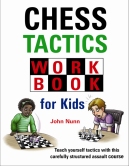
Chess tatics workbook for kids by John Nunn
2019
Gambit Publications Ltd
http://www.gambitbooks.com
E-mail info@gambitbooks.com
128 pages
Price $16.95
ISBN (13 digits):978-1-911465-31-7
(230 mm by 178 mm)
Chess Tactics Work Book for Kids is a new series of learning course books that helps young students to develop his or hers tactical skills.
Doing tactics is not only a very enjoyable time passing but there is really no better way to strengthen the positive skills of a player, because doing exercises is
all a matter of recognizing patterns.
Once you have solved a position, read the solution and learn everything you can from it.
Then the next time you will recognize the position and you will find the key idea move in no time!
The themes in this book are similar to the Chess for Kids series which we had not so long ago here on our website.
This highly instructive read holds 13 chapters where each chapter holds a basic theme as for example the Discovered Attack, where one of your pieces moves with a treat but at the same time uncovering an attack from a friendly piece.
This book is written by no less then Grandmaster Dr.John Nunn probably one of the most interesting tactical chess players of our time!
Conclusion: Highly recommended! {And not only for kids!}
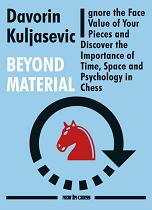
Beyond Material: Ignore the Face Value of Your Pieces and Discover the Importance of Time, Space and Psychology in Chess by Davorin Kuljasevic
2019
New in Chess
http://www.newinchess.com/
336 pages
Price € 22,95
ISBN: 978-90-5691-860-6
Grandmaster Davorin Kuljasevic from Croatia shows the reader with readable topics the techniques of winning play and many times as the author explains you have to ignore the value of your pieces but try to develop a new or improved perspective on chess in which material is seen as equivalent, and not superior to the major chess principles.
In simple words go throw these seven chapters and you will stop counting pieces as many local club players do, but you will understand more the qualitative factors such as king safety, mobility of the pieces, existence of important outposts, pawn weaknesses, initiatives and more.
Many strong players have a natural talent for such techniques, by using there knowledge of numerous patterns but as we can see in this book, these techniques can be learned.
One of Davorin Kuljasevic childhood chess heroes was Garry Kasparov and he interesting writes: Looking at his attacking games was like going through a tactical maze of variations where he would always find a way out and emerge on top. Compared to Alekhine,his attacking concepts and combinations were more complex. Kasparov would sweep his opponents of the board with relentless initiative and powerful attacks.
If you subject his annotations from Chess Informant in the 1980s and 1990s to the scrutiny of present day chess engines,you will find very few mistakes in his analysis of forced variations.
But this is not the case with Alekhine’s annotations.
A other player which Davorin Kuljasevic learned from was the great Rashid Nezhmetdinov:
Polugaevsky,Lev - Nezhmetdinov,Rashid [A53]
RSFSR-ch18 Sochi, 1958
1.d4 Nf6 2.c4 d6 3.Nc3 e5 4.e4 exd4 5.Qxd4 Nc6 6.Qd2 g6 7.b3 Bg7 8.Bb2 0-0 9.Bd3 Ng4 10.Nge2 Qh4 11.Ng3 Nge5 12.0-0 f5 13.f3 Bh6 14.Qd1 f4 15.Nge2 g5 16.Nd5 g4 17.g3 fxg3 18.hxg3 Qh3 19.f4 Be6 20.Bc2 Rf7 21.Kf2 Qh2+ 22.Ke3 Bxd5 23.cxd5 Nb4 24.Rh1 Rxf4 25.Rxh2 Rf3+ 26.Kd4 Bg7 27.a4 c5+ 28.dxc6 bxc6 29.Bd3 Nexd3+ 30.Kc4 d5+ 31.exd5 cxd5+ 32.Kb5 Rb8+ 33.Ka5 Nc6+ 0-1.
This game is well analysed with nearly two pages of text!
Conclusion: A master piece of explanation!
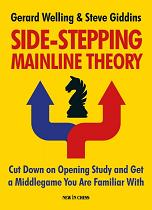
Side-Stepping Mainline Theory: Cut Down on Opening Study and Get a Middlegame You Are Familiar With
by Gerard Welling & Steve Giddins
2019
New in Chess
http://www.newinchess.com/
269 pages
Price € 22,95
ISBN: 978-90-5691-869-9
The creative master of explanation Gerad Welling and his companion FIDE master Steve Giddins provides the reader of this book with a all round repertoire, based in big lines on the
Old Indian Hanham Philidor set-up, and it does not matter if you have the white or dark side of the board.
At first glance it looks all very boring for white with a early bishop on e2, but than please see first the following game, where one of the greatest attackers of time, the famous Tartar master Rashid Nezhmetdinov is simple out played with this weird bishop.
Pachman,Ludek - Nezhmetdinov,Rashid [C44]
Bucharest Int 04th Bucharest (6), 02.1954
1.e4 e5 2.Nf3 Nc6 3.Be2 Nf6 4.d3 d5 5.Nbd2 Bc5 6.0-0 0-0 7.c3 dxe4 8.dxe4 a5 9.Qc2 Qe7 10.Nc4 Nh5 11.Re1 Bg4 12.h3 Be6 13.Bf1 Ng3 14.Bd3 Rad8 15.Ne3 Nh5 16.Nd5 Qd7 17.Rd1 Bxh3 18.Bf1 Qg4 19.Ng5 Bxg2 20.Bxg2 f5 21.exf5 h6 22.Ne6 Bxf2+ 23.Qxf2 Qxd1+ 24.Kh2 Rxd5 25.Bxh6 Qxa1 26.Bxd5 Rf6 27.Bg5 Kh8 28.Qe2 g6 29.fxg6 Kg8 30.Nf4+ Kf8 31.Nxh5 1-0.
And both authors explain: a fairly chaotic game, which shows that our solid opening does not need to presage a boring game.
{By the way tis game is also included in Ludek Pachman Meine 100 besten Partien und meine Probleme.}
I must admit the coverage of the Philidor is more than impressive with all the alternative lines, as for example the rare woolly Jobava experiment!
Throw the book I found a impressive collection of 92 model games,all well analysed plus a lot of extra pages with theoretical files!
And if you ask me this book is certainly a must buy for all lovers of the good old Philidor!
I would like to end with a game of Hans Ree who understood more of the Philidor than many other players of his time.
Ostojic,Predrag (2480) - Ree,Hans (2460) [C41]
Budapest Tungsram-03 Budapest, 08.1977
1.e4 e5 2.Nf3 d6 3.d4 Nf6 4.Nc3 Nbd7 5.Bc4 Be7 6.0-0 0-0 7.a4 c6 8.Ba2 Qc7 9.a5 exd4 10.Nxd4 Re8 11.Nf5 Bf8 12.Ng3 Nc5 13.Re1 Be6 14.Bg5 Nfd7 15.b4 Bxa2 16.Rxa2 Ne6 17.Be3 Ne5 18.b5 d5 19.b6 Qc8 20.exd5 cxd5 21.Na4 d4 22.Bd2 Nc4 23.bxa7 Rxa7 24.Nb2 Na3 25.Nd3 Qc4 26.Rb2 Rc8 27.Ne5 Qc7 28.Qg4 Re8 29.Nh5 Kh8 30.Qf5 f6 31.Nf3 Nc4 32.Bf4 Qf7 33.Rb5 Nxf4 34.Rxe8 Qxe8 35.Qxf4 Qxb5 36.g4 Ra8 37.Qc7 Qd5 38.Nh4 Rxa5 39.f3 d3 40.Qc8 0-1.
Conclusion:One of those must have chess books!
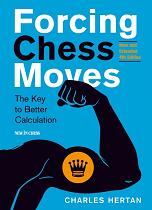
Forcing Chess Moves - New and Extended 4th Edition: The Key to Better Calculation
by Charles Hertan
2019
New in Chess
http://www.newinchess.com/
430 pages
Price € 27,95
ISBN: 978-90-5691-856-9
This New and Extended Fourth Edition of Hertan’s award-winning Forcing Chess moves is expanded with 50 extra pages.
Included is a foreword by three-time US chess champion Joel Benjamin, and it comes a special foreword by Grandmaster Pontus Carlsson.
The author has specially included for this update material how we as humans can improve our game by learning from the computer.
The computer’s lack of chess understanding is gone,and instead we try to study and understand how the machine sacrifices material for initiative. Also how they think and evaluate positions is a other interesting item.
Conclusion: This is a super read on calculations!
Chess DVD's

The nasty Nimzowitsch Defence by Christian Bauer
2019
http://www.chessbase.com
E-Mail info@chessbase.com
Price Euro 29.90
Minimum: Dual Core, 2 GB RAM, Windows 7 or 8.1, DirectX11, graphics card with 256 MB RAM, DVD-ROM drive, Windows Media Player 9, ChessBase 14/Fritz 16 or included Reader and internet access for program activation. Recommended: PC Intel i5 (Quadcore), 4 GB RAM, Windows 10, DirectX11, graphics card with 512 MB RAM or more, 100% DirectX10-compatible sound card, Windows Media Player 11, DVD-ROM drive and internet access for program activation.
The tree time French champion Christian Bauer provides the user with an impressive made 3 hours 44 minutes video coverage and in two languages of the good old Nimzowitsch Defence,1…Nc6 is in someway a odd move but on the other hand it comes with a high surprise value.
It is very interesting to compare this latest theoretical coverage of the Nimzowitsch, Defence with a classical coverage from for example from Rolf Schwarz {Aljechin und Nimzowitsch Verteidiging Kurt Rattmann 1969 },and it is hard to believe that we are discussing the same opening.
Clip seven from Christian Bauer with the interesting but dangerous line 1.Nc6 2.d4 d5 3.Nc3 Nf6 is more than spectacular!
Christoph Wisnewski in his book Play 1…Nc6 has here after 3.Nc3 nothing better than a transposing to an inconspicuous line of the French Defence that is usually reached via the move order 1.e4 e6 2.d4 d5 3.Nc3 Nc6 the so called Hecht Reefschläger line.
A fine example play of the author on this DVD is: Zeller,Frank (2420) - Bauer,Christian (2633) [B00]
SUI-chT Switzerland (8.2), 12.10.2013
1.e4 Nc6 2.Nc3 Nf6 3.d4 d5 4.e5 Nd7 5.a4 Nb4 6.f4 Nb8 7.Be3 Bf5 8.Rc1 e6 9.Nf3 Be7 10.Be2 a6 11.0-0 h6 12.Qd2 N8c6 13.Bd1 Na5 14.b3 h5 15.Ne2 h4 16.c3 Nd3 17.Ra1 c5 18.dxc5 Nxc5 19.Ned4 Bd3 20.Re1 Bg6 21.Qa2 Ne4 22.Rc1 Rc8 23.Qb2 0-0 24.Be2 Qc7 25.Kh1 Rfd8 26.Bd3 Rd7 27.Bb1 Qd8 28.Nd2 Qf8 29.Nxe4 dxe4 30.Qf2 Rd5 31.Rf1 Qe8 32.Ba2 b5 33.axb5 axb5 34.Nxb5 Rxb5 35.c4 Rbb8 36.Bb6 Nc6 37.Bb1 Nb4 0-1.
Included on this DVD are Pirc related lines plus an extra data file of over the 146 entries where many of these games are more than excellent annotated.
Conclusion: Made for advanced and stronger players!
This is ChessBase on it’s best!

Typical Mistakes by 1000-1600 Players
by Nicholas Pert
2019
http://www.chessbase.com
E-Mail info@chessbase.com
Price Euro 29.90
Minimum: Dual Core, 2 GB RAM, Windows 7 or 8.1, DirectX11, graphics card with 256 MB RAM, DVD-ROM drive, Windows Media Player 9, ChessBase 14/Fritz 16 or included Reader and internet access for program activation. Recommended: PC Intel i5 (Quadcore), 4 GB RAM, Windows 10, DirectX11, graphics card with 512 MB RAM or more, 100% DirectX10-compatible sound card, Windows Media Player 11, DVD-ROM drive and internet access for program activation.
The former World U18 chess champion Grandmaster Nick Pert knows as no other how a chess student can develop his or her chess skills.
Chess is a matter of recognizing patterns and does it all very educative, with his nearly five hour video entertainment.
I found important key patterns in tactics, openings, endgames and more.
Included are extra model games and a lot of extra exercises to see if you have learned from the great lessons of our champion!
And all perfect made for all beginners in chess!
Conclusion: Highly instructive!
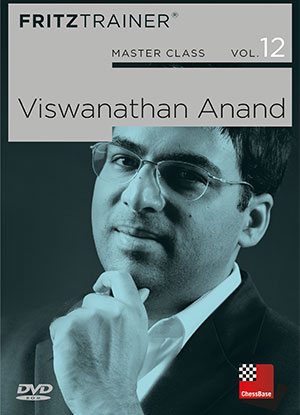
Master Class Vol. 12: Viswanathan Anand
by Dr. Karsten Müller, Mihail Marin, Oliver Reeh and Yannick Pelletier
2019
http://www.chessbase.com
E-Mail info@chessbase.com
Price Euro 29.90
Minimum: Dual Core, 2 GB RAM, Windows 7 or 8.1, DirectX11, graphics card with 256 MB RAM, DVD-ROM drive, Windows Media Player 9, ChessBase 14/Fritz 16 or included Reader and internet access for program activation. Recommended: PC Intel i5 (Quadcore), 4 GB RAM, Windows 10, DirectX11, graphics card with 512 MB RAM or more, 100% DirectX10-compatible sound card, Windows Media Player 11, DVD-ROM drive and internet access for program activation.
It is great pleasure for mr to announce the following Master Class CD from the legandary Vishy Anand who became famous for playing tournament games at breakneck speed.
A chess player who had and still has an enormous talent for the game of chess.
This well made master class DVD holds over 7 hours video entertainment, plus all Anand’s his games, and a short but very readable biography
Plus Anand’s Powerbook: The opening repertoire of the 15th world champion as a variation tree,and that is a perfect trainings tool for Fritz or ChessBase.
There is also a Tactics training file with 121 Anand games,plus 399 training questions,where it is possible to reach a maximum of 835 points.
And to forget the brilliant made ChessBase reader 2017!
A fine example of play is: Anand,Viswanathan (2779) - Van Wely,Loek (2683) [B97]
Corus Wijk aan Zee (9), 23.01.2007
1.e4 c5 2.Nf3 d6 3.d4 cxd4 4.Nxd4 Nf6 5.Nc3 a6 6.Bg5 e6 7.f4 Qb6 8.Qd2 Qxb2 9.Rb1 Qa3 10.e5 h6 11.Bh4 dxe5 12.fxe5 Nfd7 13.Ne4 Qxa2 14.Rd1 Qd5 15.Qe3 Qxe5 16.Be2 Bc5 17.Bg3 Bxd4 18.Rxd4 Qa5+ 19.Rd2 0-0 20.Bd6 Nc6 21.Bxf8 Nxf8 22.0-0 Bd7 23.Nd6 Ne5 24.Nxb7 Qc7 25.Nd6 f6 26.c4 Bc6 27.Ra1 Nfd7 28.Qd4 a5 29.Nb5 Qb6 30.Qxb6 Nxb6 31.Rd6 Nbd7 32.Nd4 Be4 33.Nxe6 a4 34.Nc7 Ra5 35.Ra6 Rxa6 36.Nxa6 Bc6 37.c5 Bb7 38.Rc1 Nc6 39.Nc7 Nd4 40.Bc4+ Kf8 41.Rd1 1-0,this game by the way well analysed on the CD or download.By the way the Poisoned Pawn with 8.Qd2 is played by Anand with both sides of the board,is one of black’s most uncompromising opening choices.
Conclusion: Highly recommended!
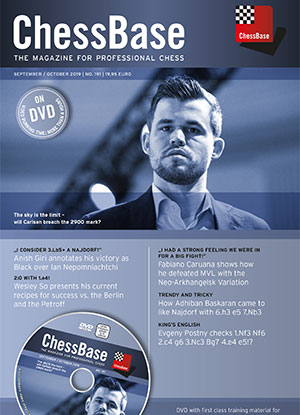
ChessBase Magazine issue 191
September - October 2019
ChessBase
http://www.chessbase.com
E-Mail info@chessbase.com
ISSN 1432-8992
Euro 19.95
System requirements:
Minimum: Pentium III 1 GHz, 1 GB RAM, Windows Vista, XP (Service Pack 3), DirectX9 graphic card with 256 MB RAM, DVD-ROM drive, Windows Media Player 9, ChessBase 12/Fritz 13 or included Reader and internet connection for program activation. Recommended: PC Intel Core i7, 2.8 GHz, 4 GB RAM, Windows 8.1 or Windows 10, DirectX10 graphic card (or compatible) with 512 MB RAM or better, 10
ChessBase comes again with a impressive overloaded ChessBase Magazine, with top tournaments {Over 1200 games and 34 annotated ones!}, opening videos as Ivan Sokolov’s first video for ChessBase where digs in the game Carlsen – YuYangyi from Stavanger 2019.
But there is more video entertainment: Ivan Sokolov: Slav – Geller Gambit
1.d4 d5 2.c4 c6 3.Nf3 Nf6 4.Nc3 dxc4 5.e4 b5 6.Be2!?
Simon Williams: Nimzowitsch-Larsen Attack
1.b3 e5 2.Bb2 e4!?
Daniel King: Najdorf Gothenburg Variation
1.e4 c5 2.Nf3 d6 3.d4 cxd4 4.Nxd4 Nf6 5.Nc3 a6 6.Bg5 e6 7.f4 Be7 8.Qf3 h6 9.Bh4 g5 10.fxg5 Nfd7
The tournaments are packed in four files {Top tournaments and more tournaments.}
A fine example of the quality the user can find here is: Carlsen,Magnus (2875) - Grischuk,Alexander (2775) [D85]
Norway Chess 7th Stavanger (3), 06.06.2019
[Heine Nielsen, Peter]
1.d4 Nf6 2.c4 g6 3.Nc3 d5! A curious moment. Norway Chess have for some years used a " Confession booth", intended for the players to give messages to the spectators during the games. Magnus took it a step further: "This is a small shout-out to Peter Heine, who thought Grischuk would play the Kings Indian, and not the Grunfeld: Clown!" The Norwegian media, as usual on the search for stories, took it seriously and as journalistic fairness dictates, contacted me during the game asking for a rebuttal! 4.cxd5 Nxd5 5.e4 Nxc3 6.bxc3 Bg7 7.Be3 c5 8.Rc1 Qa5 Grischuks stays loyal to his preferred move. [But in the next round Mamedyarov tried 8...0-0 vs. Magnus both in the classical and the Armageddon game. 9.Nf3 Nd7 10.Be2 Qa5 11.0-0 Qxa2 12.Nd2 Qa5 13.h4!? b5 14.h5 Bb7 15.h6! was the classical game. I recently attributed the modern understanding of flank pawn attacks to Alphazero, and some pointed out to me that opening the h-file and giving mate is not exactly a new concept in chess! It's a fair point, so this diagram is a good opportunity to point to what Alphazero has a preference for according to Sadler and Regan in "Gamechanger": Exactly not going for the direct assualt in the h-line but instead the slow and more cunning putrting the pawn on h6, effectively closing the h-line but instead aiming for a slower and more longterm attack. The benefits are numerous: especially it controls space at the critical area next to Blacks king, and cramping his defence, like in the game forcing the bishop to h8 where it blocks the king's potential retreat. As well in tactical sequences the pawn is only 2 squares from promoting. Not at all as direct as the typical hxg6 and mate in the h-line, but at times, much more powerful the game being a good illustration. 15...Bh8 16.e5 Qc7 17.Bxb5! Bxg2 18.Kxg2 Qb7+ 19.Qf3 Qxb5 20.Rb1 Qa6 21.Ne4 cxd4 22.cxd4 f6 23.Ng5! The "cramped" nature of Black's kingside is making itself felt with 24.Qd5+ being a deadly threat. Mamedyarov succesfully confused with 23...e6 (After 23...fxg5 24.Qd5+ e6 25.Qxd7 Blacks position is hopeless with the bishop on h8 practically being dead due to the pawns on d4, e5 and h6.) upon which Magnus blundered with 24.Ra1? (Instead, 24.Qb7! would have been deadly, as after after the exchanges of queens with 24...Qxb7+ (If 24...Qe2 25.Qxd7 wins as there is no perpetual after 25...Qg4+ 26.Kh2 fxg5 27.f3! as if Black takes twice on f3, Qxe6+ afterwards forces an eaisly winning ending, again due to the bishop being locked at h8.) 25.Rxb7 Nxe5 there is the strong 26.Nxe6! ) having missed 24...Qb6! ] 9.Qd2 0-0 10.Nf3 Bg4!? Grischuk's pet line, which he used twice at Norway Chess 2014. 11.d5 Karjakin tried 11 Ng5, but Magnus instead follows in the footsteps of Kramnik: 11...b5! [Despite winning the game vs. Kramnik 11...Nd7 12.c4 Qa3 13.Be2 Bxf3 14.Bxf3 Bd4! Grischuk decides to avoid Magnus' preparation (!) and springs his new idea first.] 12.Be2 [Critical might be to take the pawn on c5, but after
12.Bxc5 Bxf3 13.gxf3 Rc8 14.Bb4 (14.Bd4 Bxd4 15.Qxd4 Nd7 is just fine for Black.) 14...Qc7 leaves an uncoordinated impression from White, so Magnus instead reverts to common-sense development] 12...Nd7 13.0-0 Bxf3?! Grischuk after the game said that 11...b5 was old prep and that his recollection was that the computers back then said Black was better, meaning he was in "refutation mode", playing principled decisions to expose the flaws of the white position. Modern engines, however, have modified their views, and think Black is fine but not more. 14.Bxf3 Common sense, but 14.gxf3 followed by either f4, or h4 has definite potential too. 14...c4 15.Be2 One does not have to be Alphazero to suggest 15 h4! here, Stockfish prefers it too! Magnus, however, goes for first setting up a broad centre, and then develop his attack on the wing. [15.h4!?] 15...Rfd8?! As in move 13, Grischuk is too colored by the idea of having a good position and thus plays too ambitiously aiming for rooks on d8 and c8. [15...Rad8! however was more to the point, caring about defensive details like the rook leaving tha a8-square this not being targeted by a white bishop on f3m but especially leaving the rook on f8, where it defends the upcoming assult in the f-line, as well as being ready to counter there itself. 16.f4 Qa3 17.Bf3 when now 17...Nc5 18.e5 f6! makes a considerable difference to the game.] 16.f4! Nb6 [The big difference now is that 16...Qa3 17.Bf3 Nc5 18.e5 f6 19.d6! hitting a8 is possible, when after 19...Rac8 20.Bd5+ e6 21.f5! Whites attack just crashes through.] 17.Bf3 Qa3 18.h4!? In a later interview Magnus mentioned Alphazero and Danil Dubov as his current chess heroes! One does see the inspiration, with the optimistic and untamed long-term aggression. There is no immediate threat, and Black's counterplay might even get there first, but White does aim after the king, and will hit substantially harder than Black's smaller threats when the attack arrives at the intended target. 18...e6 [18...b4!? aims at distracting white immediately, but he will just ignore with 19.h5! as 19...Bxc3 20.Qf2 might have won Black a pawn and created two passed pawns on the queenside, but White couldn't care less as he intends to finish the game way before such becomes decisive. After 20...Bg7 21.hxg6 hxg6 both 22.Bg4 (and 22.f5 Rf8 23.e5!?) 22...b3 23.f5 g5 24.f6 exf6 25.axb3 cxb3 26.Rc7 gives White a very promising attack.] 19.h5! Na4 [Grischuk's problem is that 19...exd5 20.e5! just makes things even worse as again Black gets an useless extra pawn while speeding up Whites' attack, with Bd4, f5, Bg4 etc. being the next wave.] 20.hxg6 Not h6! this time but hxg6. Yes, White has thus spent two tempi opening the h-line, apparantly to little effect!? Partly it does weaken the g6 pawn, later being a subject to a possible attack, but as we soon will see, the open h-line very much do has relevance. 20...hxg6 21.f5 exf5 [21...Bxc3 obviously is critical, but apart from just sidestepping with his queen, White has this even mightier exchange sac: 22.Rxc3! when his attack becomes just unstoppable. 22...Qxc3 23.Qf2 Now 24.Bd4 is a deadly threat, and 23...Qg7 24.fxe6 fxe6 25.Bg4! highlights why the h-line being open does make a major difference, with B(x)e6+ followed by Qh4+ as the deadly threat.] 22.exf5 Qd6 23.Bf4 Qb6+ 24.Kh1 gxf5 25.d6! Grischuk staved off immediate defeat, but the next wave of attack he is helpless against. 25...Rab8 26.Bd5 Nc5 27.Bg3 Ne6 28.Rxf5 Now Rxf7 is a threat. 28...Rxd6 29.Bxd6 Qxd6 30.Qe3 Qb6 31.Qf3 Rf8 32.Rf1 Nd8 33.Rh5 Qc7 34.Qe4 And where fittingly the open h-line gets the final word. Mate on h7 is unavoidable so Grischuk resigned. 1-0.
But there is more as super analysis and smashing opening lines as the one from Krisztian Szabo on the French Winawer:Van Foreest,Jorden (2595) - Ider,Borya (2456) [C18]
FRA-chT Top 12 Chartres (7.7), 24.05.2017
[Szabo, Krisztian]
1.e4 e6 2.d4 d5 3.Nc3 Bb4 4.e5 c5 5.a3 Bxc3+ 6.bxc3 Ne7 7.Qg4 0-0 8.Bd3 f5 9.exf6 Rxf6 10.Bg5 Rf7 11.Qh5 g6 12.Qd1 Qa5 13.Nf3 Rxf3!? 14.gxf3 Qxc3+ 15.Kf1 c4 [15...Nbc6?! is dubious now due to 16.dxc5! e5 (16...Qxc5 17.h4±) 17.h4 Be6 (A.Rudolf-Jurek, Pardubice 2007) 18.Rb1± and White stands better because of the exposed b7-pawn which serves as an obvious target.] 16.Bxe7 cxd3 17.cxd3 Qxd4 18.h4 e5 [18...Nc6!? 19.Bg5 h5 a) 19...Ne5 20.Rc1 White's pawn structure is not so great, but his rook is very active on the c-file, threatening to penetrate on c7. 20...Bd7 (20...Nxd3? 21.Be3+-) 21.Be3 Qxd3+ 22.Qxd3 Nxd3 23.Rc7± Ciani-Staak, ICCF email 2013; b) 19...Qe5 20.f4 Qg7 21.f5! exf5 (21...e5 22.f6±) 22.Kg2 f4 b1) 22...b6?! 23.Re1 Bb7 (P.Papp-Osborne, London 2015) 24.Qe2±; b2) 22...h6?! 23.Bf4 Be6 (23...g5 24.hxg5 hxg5 25.Kf1!±) 24.Qd2 Kh7 25.Rhe1²; b3) 22...Be6 23.Re1 Qd7 24.Qd2 d4 25.Qf4 Bd5+ 26.f3²; 23.Qf3 Be6 24.Qxf4 Rf8 25.Qe3 Qd7 26.Rhe1 Bg4 27.Bf4f; 20.Rb1 b6 21.Kg2 Bd7 22.Rc1 Rf8 This is a very intriguing middlegame. From my perspective, Black has compensation for his exchange as White's rooks are passive and can't be activated. 23.Re1 e5 24.Re3 Rf5 25.Qb3² Cumming-Mesquita, ICCF email 2015] 19.h5 [19.Kg2!?] 19...Bf5 20.Kg2 Nc6 21.Bg5 Qxd3 22.Qxd3 Bxd3 23.Rad1 Bc4 24.hxg6 hxg6 25.Rh6 Kf7 26.f4² Rg8? [26...e4] 27.fxe5 Nxe5? [27...d4 28.f4±] 28.Re1 Nc6 29.Rh3 [29.Rh7+! Rg7 30.Rh3!+-] 29...Rf8 30.Rh7+ Kg8 31.Rxb7 Rf7 32.Re8+ Kg7 33.Be7 d4 34.Rd7 d3 35.Bf8+ Kh7 36.Rxf7+ Bxf7 37.Re3 Bc4 38.Bb4 Nxb4 39.axb4 Kh6 40.Re7 a6 41.Kf3 Kg5 42.Ke3 Kf5 43.Rc7 Bb5 44.Rc5+ Ke6 45.Rg5 Kf6 46.Kf4 Bc4 47.Rg1 Bb5 48.Rd1 Bc4 49.Re1 Bb3 50.Ke3 Bc4 51.Rc1 Bb5 52.Rc5 Ke6 53.Rc7 Kf6 54.Rc8 Ke6 55.Rd8 Ke5 56.Rd4 Kf5 57.Re4 Kf6 58.Kf4 g5+ 59.Ke3 Kf5 60.Re7 Kf6 61.Rc7 Ke6 62.Rc5 Kf6 63.Rd5 Bc4 64.Rd4 Bb5 65.Ke4 Ke6 66.Rd8 Ke7 67.Rd4 Ke6 68.f3 Bc6+ 69.Ke3 Bb5 70.Rg4 Kf6 71.Rg1 Kf5 72.Rg2 Kf6 73.Ke4 Bc4 74.Rh2 Kg6 75.Ke5 Bb5 76.Rd2 Kh5 77.Rg2 Bc6 78.Kf5 Kh4 79.Rg4+ Kh3 80.Kxg5 Bxf3 81.Rd4 Be2 82.Kf4 Kh4 83.Rd5 Bf1 84.Ke3 Kg4 85.Kf2 Be2 86.Ke3 Bf1 87.Rd6 Kf5 88.Rxa6 Ke5 89.Ra1 Be2 90.Kd2 Kd6 91.Rc1 Bg4 92.b5 Kd5 1-0.
Other contributions are Williams: Move by Move,Rogozenco: The Classic, Marin The knight less Isolani,Reeh Tactics,Knaak:Recent opening traps,plus a superb contribution from the great endgame specialist Karsten Müller where he presents a varied selection of knight endgames.
Included is a eye catching booklet in two languages.
Conclusion: This is a must have material!